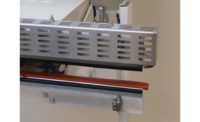
|
| Pictured here is the Huishan Pourable Pouch. |
The requirements for improving the effectiveness of heat-sealing – while ensuring shorter cycle times – are constantly evolving. And the focus on these requirements is only intensifying as more applications are converting from rigid to flexible packaging, where heat sealing is more critical to maintain package integrity.
Resin manufacturers are constantly trying to alter chemistry to produce polymers with lower heat-initiation temperature. Film converters are under constant pressure to downgauge the sealant layer without compromising the seal integrity. And laminators and pouch manufacturers are constantly striving to shorten cycle times on packaging lines to maintain efficiency.
Every player in this cycle understands that optimizing heat sealing is one guaranteed way to achieve faster cycle times and maintaining all important seal integrity.
Beyond Seal Strength
Not too long ago, the most important criterion for a package was to have strong heat seals that maintained integrity and avoided failure. Then the trend shifted from strong seals to ‘easy peel’ seals. Consumers wanted safe food packaging, but they also wanted to be able to open it.
This had film manufacturers and converters looking more closely at sealing temperatures, where the seal strength increases as the temperature increases, and vice versa. By playing within the admittedly narrow temperature range for thermoplastic polymers, certain seals could be made strong enough to maintain integrity but not so strong as to make the seal near impossible to break.
But for packaging of liquids and higher bulk-density materials by form, fill and seal method, ‘easy peel’ posed a challenge for the seals on the pouch. Emergence of newer materials and sealing technologies created a need for more accurate, reproducible methods of measuring heat sealing capabilities for real life use.
The stress on repeatable results, free from human interference, made older methods like falling weight or the spring test methods irrelevant. The results generated by these rough, pass-or-fail methods were inappropriate for the strict demands of true quality control, research and development.
This is how hot tack testing became so important.
Hot Tack Testing: How it Works
Hot tack strength is generally defined as the capability of a heat seal joint to hang together when it is stressed, while still hot from the sealing operation.
|
To achieve guaranteed heat-sealing it is important to have the following:
|
The hot tack tester provides an accurate and consistent method of testing the sealing properties of a wide range of materials. Touch-screen computer software allows the operator to quickly change key parameters such as pressure, temperature and dwell time. The built-in load cells measure the actual force applied to the film. The computer-controlled temperature assures an accuracy of +/- 10 C across the entire width of the film sample. The automatic sample loading tray ensures accurate test results by eliminating any chance of user inconsistencies in testing procedure. The automatic tray inserts the sample without variation and enhances safety. Fitments are designed to prevent slippage or premature release of the sample material. The resulting seal force can be presented in grams, Newtons or pounds (lbs) by customizing the software.
Independent upper- and lower-sealing temperatures further enhance the testing capabilities. Measurement of cold seal strength allows comparison between hot tack strength and ultimate strength of seals.
The computer interface and the specifically designed software for hot tack testing enable the data to be captured and graphically displayed, along with test criteria for each file of testing. Testing confirms to the ASTM F 1921-98 test method producing load versus time and load versus temperature curves.
The advent of sophisticated hot tack / heat sealers backed by slick software helps R&D eliminate the need for expensive trials at customer site. It enhances the ability of the supplier to duplicate customer machine set up in the lab, design and test the package under production conditions long before it actually reaches the customer.







